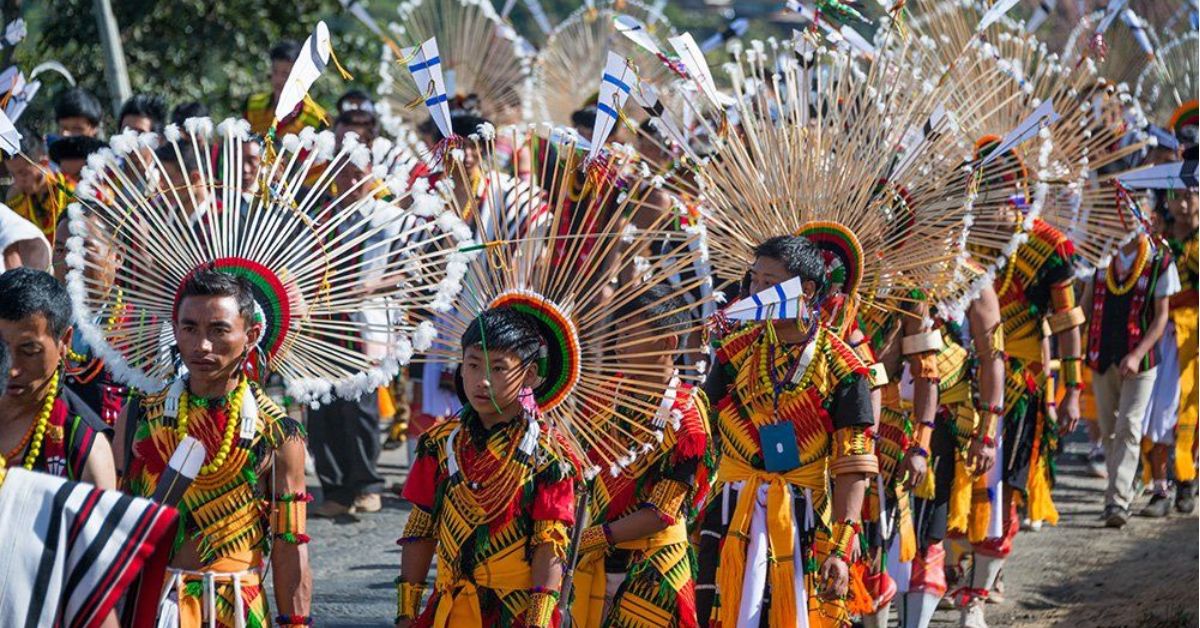The Naga Heritage Village is a special place nestled in the beautiful hills of Nagaland. It’s like a living museum where you can learn about the amazing Naga people. Not far from Kohima, the capital city, this village is a window into the old ways of life, crafts, and traditions of the different Naga tribes.
With its traditional houses and lively shows, the village is a place to celebrate the rich history and culture of Nagaland. Whether you love learning about cultures, history, or just exploring new places, this is a great spot to experience the heart and soul of one of India’s most unique and colorful regions.
How to reach:
By Air:
The closest airport to the Naga Heritage Village is in Dimapur, about 74 kilometers from Kohima. You can fly there from big cities like Kolkata, Guwahati, or Delhi. Once you land, you can take a taxi or hire a car to reach Kohima. The drive takes about 2-3 hours.
By Train:
Dimapur also has a main train station with trains to Guwahati and Kolkata. From there, you can take a taxi or bus to Kohima. The journey by road takes about 2-3 hours.
By Road:
You can travel to Kohima by bus or taxi from other parts of Nagaland or nearby states. The drive from Dimapur to Kohima is beautiful, with nice views of the Naga hills. There are many buses and taxis going between these two places.
Best time to visit:
October to April: The Ideal Time
This is the best time to visit Nagaland, including the Naga Heritage Village. The weather is cool and dry, perfect for exploring. Days are pleasant, usually between 15°C and 25°C. You’ll avoid the heavy rains of the monsoon season.
Festival Fever: December Magic
Visiting during the Hornbill Festival in early December is a fantastic choice. This huge celebration showcases Naga culture with dancing, music, and crafts. The Heritage Village is part of the fun, making it a great time to experience traditions.
Monsoon Months: June to September
While the landscape is lush and green during the monsoon (June to September), heavy rain can make travel tricky. If you don’t mind the rain and prefer quieter times, this could work. Just be prepared for wet weather.
Summertime: May and June
It gets warmer from May to June, with temperatures around 30°C. It’s less crowded, but the heat might not be for everyone.
Attractions:
Traditional Naga Huts:
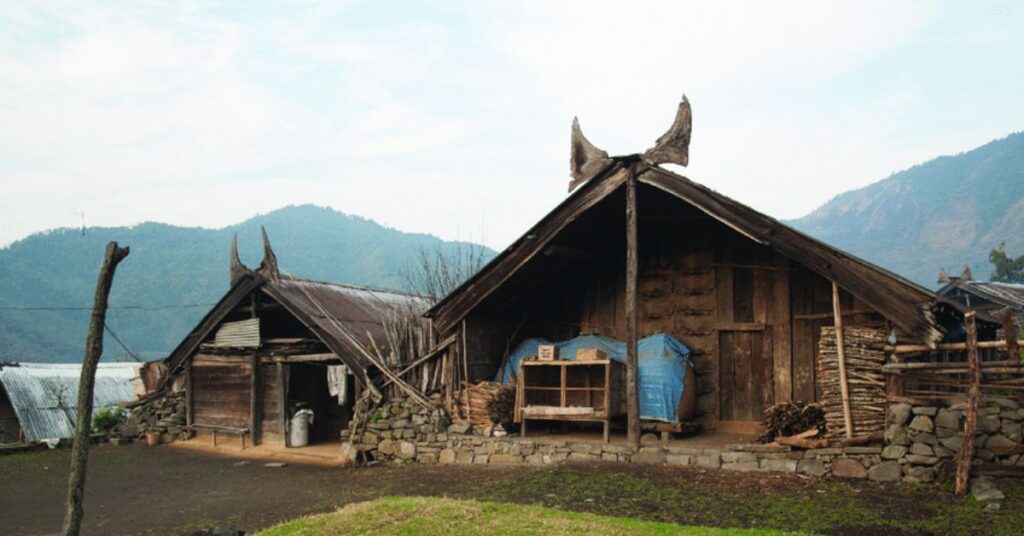
The Naga Heritage Village is full of amazing traditional homes that tell stories about the Naga people. These houses are built with natural things like bamboo and wood, and each one shows the special style of a different Naga tribe. They aren’t just houses; they’re like time machines that take you back to how Naga people lived, worked together, and understood the world around them. From the beautiful carvings on the wood to the clever ways they used bamboo for walls and roofs, every part of these homes has a meaning. You can walk around inside and really feel like you’re stepping back in time. It’s like having a real-life picture book about how Naga people lived.
Cultural Exhibitions:
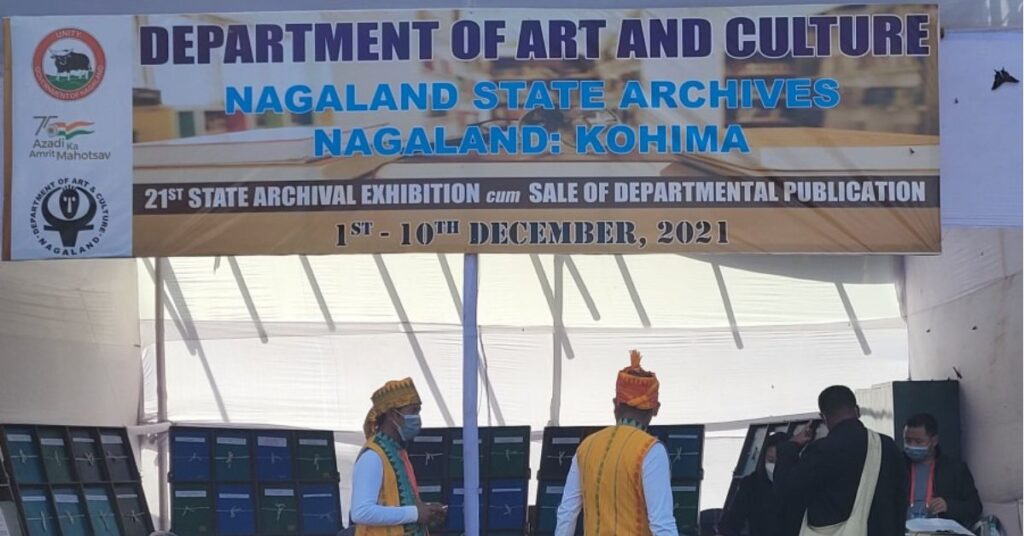
The Naga Heritage Village shows off the amazing things the Naga people make. You can see beautiful beadwork, special clothes for ceremonies, and old weapons. Each piece is really special and tells a story about the Naga way of life.
The displays explain how these things were used and what they mean. You can look at the colorful clothes with their fancy beads and feathers and learn about the special times people wear them. It’s like a big classroom where you can learn all about the Naga people and how clever they are.
Folk Performances:
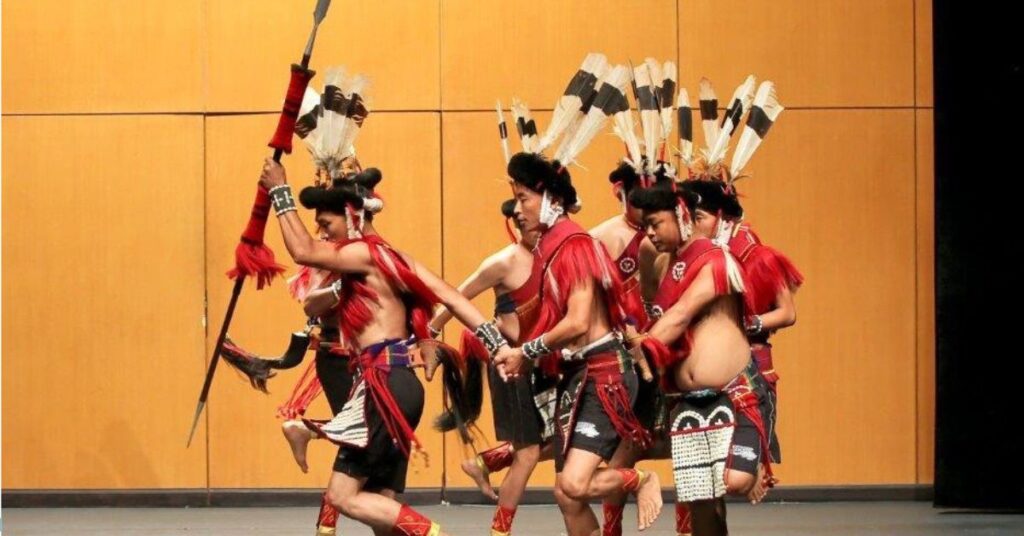
The Naga Heritage Village is a place where you can see the Naga people’s amazing dances, music, and stories come to life. They wear beautiful clothes and do cool moves that tell old tales and celebrate special days. The music is made with special instruments like drums and flutes, and it makes the dancing even more exciting.
Watching these shows is like stepping into a different world. You can feel the energy and happiness of the Naga people. It’s a really fun and unforgettable experience!
Traditional Rituals and Festivals:
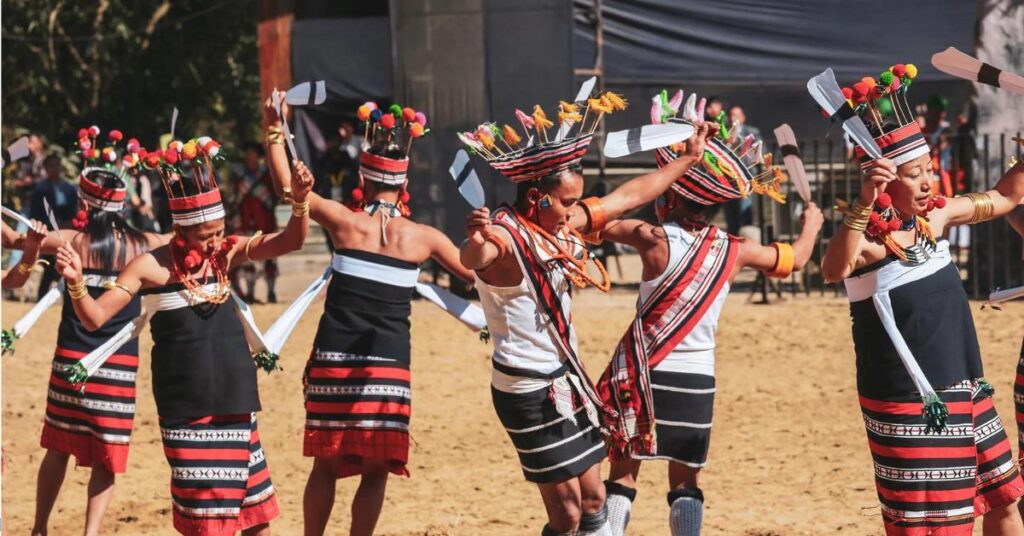
Seeing Naga traditions in action is amazing! The Heritage Village lets you watch and join in the fun of their special ceremonies and festivals. There’s music, dancing, and big feasts. The Hornbill Festival is super famous and has everything – from dancing to crafts and games. Watching these old traditions helps you understand what the Naga people believe and how they live. It’s like being part of one big happy family!
Local Experiences:
- Join the Fun: Be part of lively festivals like the Hornbill Festival, with dancing, music, and cultural shows.
- Enjoy the Show: Watch amazing Naga dances and listen to their beautiful music that tells old stories.
- Explore the Homes: Visit traditional houses of different Naga tribes to learn how they lived.
- See Crafts in Action: Watch skilled people make things like woven cloth, pottery, and wood carvings. You can even buy their handmade items!
- Taste the Flavors: Try delicious Naga food like smoked pork, bamboo shoot curry, and special rice dishes.
- Learn About the Past: Visit the museum to see old things, read about history, and learn about Naga life through fun displays.
- Experience Traditions: If you’re lucky, you might see special ceremonies and learn about Naga beliefs and customs.
- Relax and Enjoy: Take a peaceful walk and admire the beautiful hills around the village.
- Meet the People: Talk to the people who live there to learn about their lives, traditions, and culture.
Travel tips:
Check the Weather: Look at the weather before you go, especially if it’s the rainy season. Heavy rain can change your plans.
Dress Comfortably: Wear clothes that are easy to move in and match the weather. Bring a jacket for cooler evenings and a raincoat if needed.
Bring Cash: Many places don’t take cards, so bring enough cash for things you want to buy.
Get a Guide: A local guide can tell you lots of interesting things about the Naga people and their history.
Respect the Culture: Be polite and follow the Naga people’s customs, especially during special events. Ask before taking photos.
Plan Your Trip: Figure out how you’ll get around, especially from Dimapur or Kohima. A taxi or renting a car is a good idea.
Stay Prepared: Bring water and snacks because food choices might be limited.
Know the Hours: Check when the Heritage Village is open and if there are any special events happening.
Stay Safe: Follow any safety rules or advice from the local people, especially during rainy times or outdoor activities.
Meet the People: Talk to the people who live there to learn more about their lives and traditions.
Conclusion
The Naga Heritage Village offers a captivating journey through the heart of Nagaland’s rich culture. This living museum showcases the vibrant traditions of the Naga people, from traditional dwellings and intricate artifacts to lively performances and local cuisine. Immerse yourself in the region’s heritage, witnessing firsthand the artistry, customs, and spirit of the Naga tribes. It’s an unforgettable experience that bridges the gap between the past and present, leaving you with a profound appreciation for this fascinating region. Follow Xplro for more and thanks for visiting us.
FAQs
1. What is the Naga Heritage Village Complex?
- The Naga Heritage Village Complex is a cultural attraction in Nagaland that offers a comprehensive look into the traditional life, architecture, and customs of the Naga tribes. It features authentic tribal huts, cultural exhibits, traditional performances, and displays of local crafts.
2. Where is the Naga Heritage Village Complex situated?
- The complex is located about 12 kilometers from Kohima, the capital city of Nagaland. It can be easily reached by road from Kohima and Dimapur.
3. What are the visiting hours for the Naga Heritage Village Complex?
- The complex is typically open every day from 9:00 AM to 4:00 PM. However, it’s a good idea to verify the hours before your visit, as they might change or vary seasonally.
4. Is there an admission fee to enter the Naga Heritage Village Complex?
- Yes, there is usually a small entry fee for visitors. The fee may vary, so it’s best to confirm the current rate either at the gate or via the complex’s official communication channels.
5. When is the ideal time to visit the Naga Heritage Village Complex?
- The ideal time to visit is between October and April when the weather is generally mild and favorable for outdoor activities. The Hornbill Festival in early December is also a great time to visit if you want to experience vibrant cultural events.
6. How do I get to the Naga Heritage Village Complex?
- You can travel to the complex by road from Kohima, which is about a 30-minute drive away. Dimapur Airport and Dimapur Railway Station are the nearest major transport hubs, with road connections to Kohima.
7. Are guided tours available at the Naga Heritage Village Complex?
- Yes, guided tours are available and can provide valuable insights into the cultural and historical significance of the complex. It’s advisable to arrange a guide in advance if you prefer a more in-depth experience.
8. Can I take photos at the Naga Heritage Village Complex?
- Photography is generally permitted, but it’s important to ask for permission before photographing individuals, especially during traditional performances or private settings. Respecting local customs and privacy is essential.
9. What should I wear for a visit to the Naga Heritage Village Complex?
- Dress comfortably according to the weather conditions. It’s helpful to wear layers for cooler evenings and bring rain gear if visiting during the monsoon season. Comfortable walking shoes are recommended for exploring the site.
10. Are there food and drink options available at the complex?
- Food and beverage options within the complex might be limited, so bringing your own water and snacks is a good idea. You can find local dining options in the nearby area to enjoy traditional Naga dishes.
11. Is the Naga Heritage Village Complex accessible to visitors with disabilities?
- Accessibility may vary, so it’s a good idea to contact the complex ahead of time to check for available facilities and accommodations for visitors with disabilities.
12. Can I buy souvenirs at the Naga Heritage Village Complex?
- Yes, there are usually opportunities to purchase souvenirs and traditional crafts from local artisans. These might include items such as handwoven textiles, wooden carvings, and other cultural artifacts.




